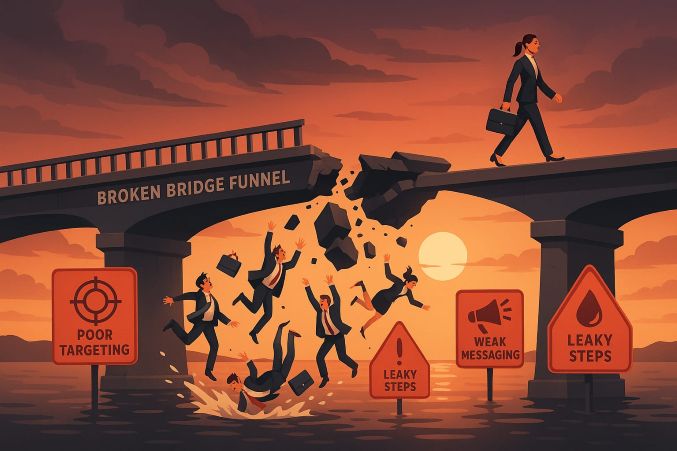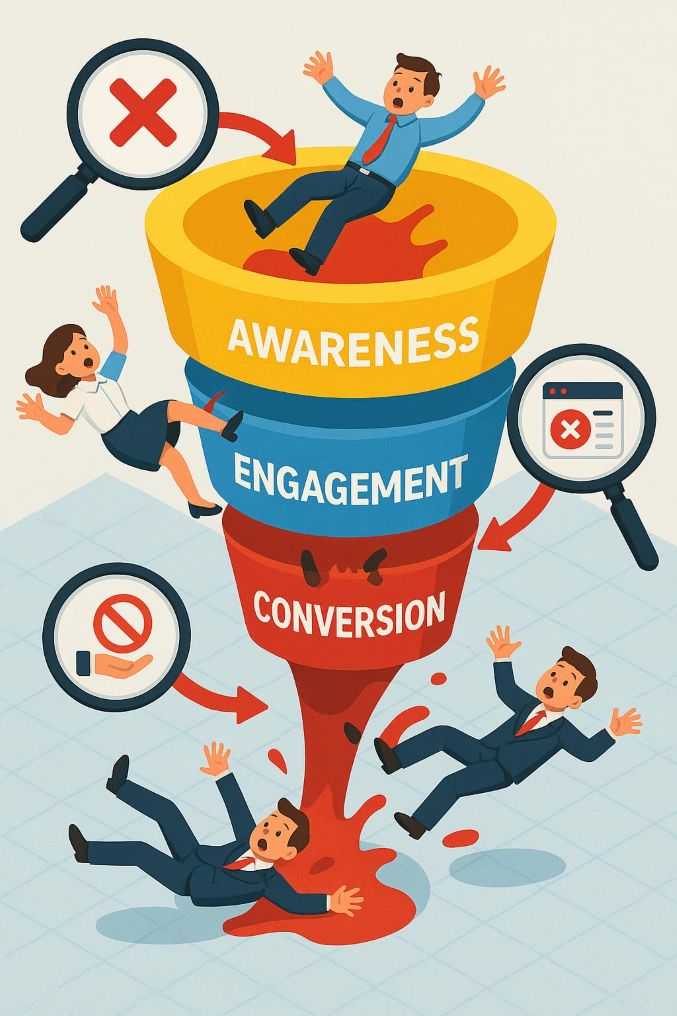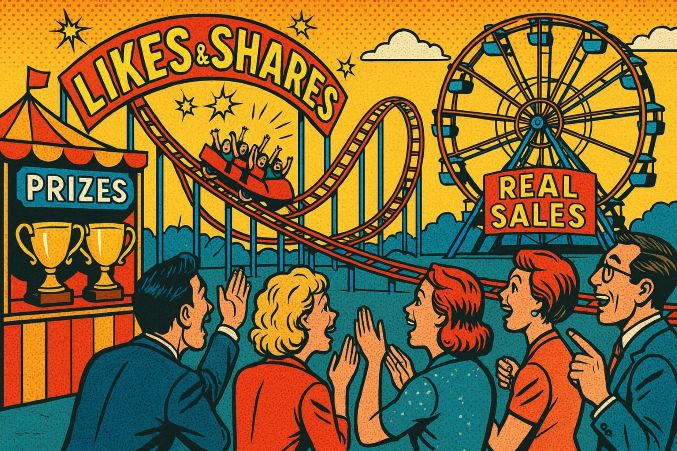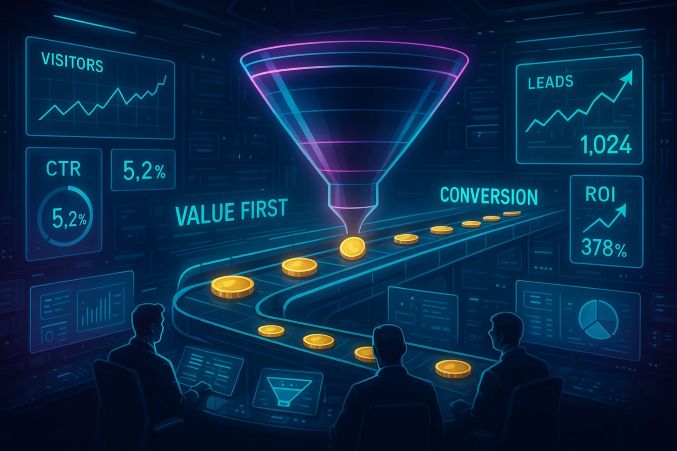Why Most Social Media Funnels Fail (And What the Top 1% Do Differently)
Social media funnels are essential for turning followers into paying customers. Yet, most brands struggle to make them work—while the top 1% consistently generate high conversions.
What’s the difference?
In this deep dive, we’ll explore why 90% of social media funnels collapse before making sales and what elite brands do differently to dominate their markets.

1. The Harsh Truth: Why 90% of Social Funnels Fail Before the Sale
The majority of social media funnels don't work due to focusing on the wrong things—vanity metrics, poor offers, and bad targeting. Here's why they don't work:
Common Funnel Failure Reasons:
- Weak Targeting: Brands use a broad net instead of targeting high-intent consumers.
- Weak Messaging: Generic copy that doesn't speak to pain points or wants.
- Leaky Steps: Absence of micro-commitments (e.g., not cultivating leads prior to pitching).
- Overcomplication: Excessive steps, distractions, or ambiguous CTAs.
- Lack of Trust: Absence of social proof, testimonials, or credibility builders.
Solution: The 1% prioritize hyper-targeted audiences, compelling value propositions, and seamless user experiences.

2. The Broken Funnel: Where Most Brands Lose Their Audience
A funnel is only as strong as its weakest link. Most brands lose potential customers at critical drop-off points:
Key Drop-Off Points:
- Awareness Stage: Advertising or posts don't catch attention (weak hooks, unimportant visuals).
- Engagement Stage: Materials don't create interest (no narrative, no emotional triggers).
- Conversion Stage: Offer isn't attractive (weak CTA, unvisible benefits).
Example:
- A company places an ad with high view but low click → Weak hook or inappropriate audience.
- Traffic on a landing page but no conversion → Bad offer or excessive friction.
Solution: The #1% plan out every step, friction-optimize for engagement, and eliminate friction points.
3. From Clicks to Customers: Why Vanity Metrics Mislead Marketers
Most marketers love likes, shares, and impressions—but those don't put food on the table.
Why Vanity Metrics Are Harmful:
- High Reach ≠ High Sales: A 100K-view post with no conversions is useless.
- Engagement Bait: Certain content receives shares but does not lead to buys (e.g., memes, viral trends).
- Algorithm Trap: Platforms only reward engagement, not sales—so brands optimize for the wrong metric.
Solution: The top 1% measure relevant KPIs:
- Click-through rate (CTR)
- Cost per lead (CPL)
- Conversion rate (CVR)
- Customer lifetime value (LTV)
4. The Top 1% Playbook: What Elite Brands Do Differently
Top-performing funnels take a tried-and-tested, user-first approach:
Secrets of Elite Funnels:
✅ Lead with Value: Free content, quizzes, or lead magnets that appeal to the right audience.
✅ Sequenced Messaging: They don't pitch too early—they warm up leads first.
✅ Frictionless UX: Easy-to-load pages with prominent, easy-to-read CTAs.
✅ Psychological Triggers: Urgency, social proof, and scarcity (without being aggressive).
Example:
- Shopify warms up leads using free tools (profit calculator, business name generator) before pitching.
- HubSpot provides free courses and templates prior to selling their CRM.
5. Offer Strategy: Why Most CTAs Fail to Trigger Action
A bad call-to-action (CTA) can kill conversions. Here's why most fail:
Common CTA Missteps:
- Unclear Language: "Learn More" vs. "Get Your Free Trial Now"
- Lacking Urgency: "Buy Whenever" vs. "Limited Spots Left!"
- Poor Placement: Hidden below the fold or buried in clutter.
What's Effective?
- Direct & Actionable: "Start Your Free Trial"
- Benefit-Focused: "Get 50% Off Today Only"
- Risk-Free: "7-Day Money-Back Guarantee"
Solution: The best 1% test different CTAs and apply urgency + exclusivity.
6. The Power of Pre-Suasion: How Elite Brands Warm Up Leads Before the Ask
Humans don't purchase from strangers—they purchase from brands that they know, like, and trust.
How Top Brands Condition Their Audience:
- Educational Content: Blogging, videos, and webinars establishing authority.
- Engagement Hooks: Polls, quizzes, and interactive storytelling to boost engagement.
- Storytelling: Emotional storytelling that connects before selling.
Example:
- Nike doesn't sell shoes—they sell inspiration via athlete stories.
- Glossier established a cult following through user-generated content before products.
Solution: Provide value first, then sell.
7. Segmentation vs. Personalization: The Top 1% Funnel Edge (Above Basic Demographics)
Generic messaging is the quiet assassination of conversions. The top 1% don't only segment—they hyper-personalize based on actual behavior in real-time.
Why 87% of Marketers Suck at Personalization (And Winners Get It Right):
- Cold Traffic vs. Warm Leads:
- Cold audiences are exposed to educational content (e.g., "Beginner's Guide to SEO")
- Warm leads receive case studies (e.g., "How [Similar Business] 3X Revenue")
- Hot leads are offered limited-time deals (e.g., "Your Exclusive 24-Hour Deal")
- Psychographic Layers:
- A high-end brand appeals to "aspirational spenders" with prestige messaging
- A penny-pinching brand appeals to "practical savers" with cost-benefit analyses
- AI-Powered Dynamic Content:
- Shopify stores display abandoned cart products in Facebook ads
- Email subject lines automatically insert first names + last viewed product
Case Study:
Netflix's "Top 10 in Your Country"
- Uses viewing history + geographic trends to dynamically personalize thumbnails
- Delivers 30% higher click-through rates than generic recommendations
Actionable Framework:
- Install Hotjar Recordings to observe how various users experience your site
- Utilize Meta's Advantage+ Audiences for AI-powered ad personalization
- Implement Google Analytics 4 custom segments on:
- Pages visited
- Time spent
- Scroll depth

8. Retargeting Strategy: The 7-Touch Rule Most Brands Ignore (But Amazon Uses Daily)
The typical customer requires 7+ touchpoints before they purchase—yet the majority of brands give up after 2 retargeting ads.
The Tiered Retargeting Matrix Top Brands Use:
|
Touchpoint |
Ad Type |
Psychological Trigger |
|
1st (Awareness) |
Broad video ad |
Curiosity ("Did you know?") |
|
3rd (Consideration) |
Carousel ad with advantages |
Social proof ("10,000+ users") |
|
5th (Decision) |
Dynamic product ad |
Scarcity ("Low stock alert") |
|
7th (Conversion) |
SMS/email promotion |
Loss aversion ("Your cart expires") |
Effective Strategies:
- Sequential Storytelling:
- Day 1: "Meet [Product]" (Brand narrative)
- Day 3: "How [Product] solves [Pain Point]" (Demo)
- Day 7: "Last chance for [Offer]" (Sense of urgency)
- Cross-Platform Retargeting:
- Facebook ad → YouTube follow-up → Google Search remarketing
- Exclusion Lists:
- Exclude converted users (waste $0 ad spend)
Data Point:
Brands using tiered retargeting realize 4.2X greater ROAS (Nielsen study)
9. Conversion Architecture: The 3-Second Rule That Determines 80% of Funnel Success
You have 3 seconds to demonstrate your page is worthy of consideration. Here's how top brands craft perfection:
The Military-Grade Funnel Checklist:
Above the Fold (Must Haves):
✅ Hero Section:
- Clear value prop ("Get [Result] in [Time]")
- Supporting subhead ("Used by [Credible Brand]")
✅ Visual Hierarchy: - Eye path: Logo → Headline → CTA → Trust badges
- F-pattern layout for readability
✅ Mobile-Optimized: - Thumb-friendly CTAs (min 48x48px)
- Accelerated Mobile Pages (AMP) for sub-1s loads
Below the Fold (Advanced):
Micro-Commitments:
- "Yes, I want [Result]" checkboxes prior to forms
- Mini-quizzes ("Select your goal") to raise investment
Sticky Elements: - Floating CTA bars on scroll
- Exit-intent popups with lead magnets
A/B Test Winners:
- Changing CTA button color raises conversions 21% (VWO)
- Including a benefit-driven bullet list raises conversions 17% (Unbounce)
10. Relentless Testing: How the Top 1% Run 237% More Experiments Than You
While most marketers make educated guesses, high-growth teams let data make the decisions.
High-Growth Teams' Testing Pyramid:
Layer 1: Quick Fire Tests (Weekly)
- Headline tests (Emotional vs. Direct)
- CTA tests (Sticky vs. Inline)
Layer 2: Structural Tests (Monthly)
- Single-step vs. multi-step checkout
- Long-form vs. short-form sales pages
Layer 3: Nuclear Tests (Quarterly)
- Funnel redesigns
- Offer stack redesigns
Testing Tools Tier List:
Gold Standard: Google Optimize (Free) + Hotjar
Pro Tier: VWO ($3,000+/mo)
Starter: Facebook's A/B Testing (Free)
Case Study:
Dollar Shave Club
- Ran 137 headline tests before settling on "Shave Time. Shave Money."
- Lifted 12% in signups (valued at millions every year)

11. Trust Layers: How to Use "Invisible Selling" Like Apple (Without Feeling Pushy)
Humans purchase when they forget they're being sold.
The Trust Stack Hierarchy:
- Social Proof:
- "3,247 satisfied customers this month" counters
- LinkedIn employee quotes (more trustworthy than CEO statements)
- Authority:
- "As seen in [Forbes/TechCrunch]" badges
- Certifications (ISO, BBB A+)
- Transparency:
- Live inventory counters ("17 people looking at this")
- Unscripted team videos ("Meet our real support staff")
Psychological Hack:
Position trust elements right of CTAs—eye tracking demonstrates this boosts conversion confidence by 33% (Baymard Institute)
12. Real Funnels Decoded: The $100M+ Playbooks You Can Steal
Shopify's "Free Trial" Funnel (Step-by-Step):
- Top of Funnel:
- YouTube ads for "how to start online store" searches
- Hook: "How This 19-Year-Old Made $27,392 in 30 Days"
- Middle Funnel:
- Free tools (Business name generator + logo maker)
- Email sequence: "Here's your store name → Now claim your 14-day trial"
- Bottom Funnel:
- One-click upsell: "Add payment processing (Recommended)"
- Onboarding emails: "Your first sale is 83% more likely if."
Conversion Rate: 4.3% (3X industry average)
DTC Secret Weapon: Gymshark's UGC Engine
- Phase 1: Send free products to micro-influencers (10K-50K followers)
- Phase 2: Run hashtag challenges (#Gymshark66) with repost rewards
- Phase 3: Feature top UGC in paid ads ("Real people. Real results.")
Result: 58% of their content is user-generated, without spending millions in production
Nuclear Takeaway:
The difference between mediocre and elite funnels isn't creativity—it's sequential application of these 12 layers.
Which funnel lever will you optimize first?
- Hyper-segmentation
- Tiered retargeting
- Military-grade CRO
- Atomic testing
- Invisible trust stacking
Comment below—We"ll answer with a tailored action plan!


Comments
No Comments To Display